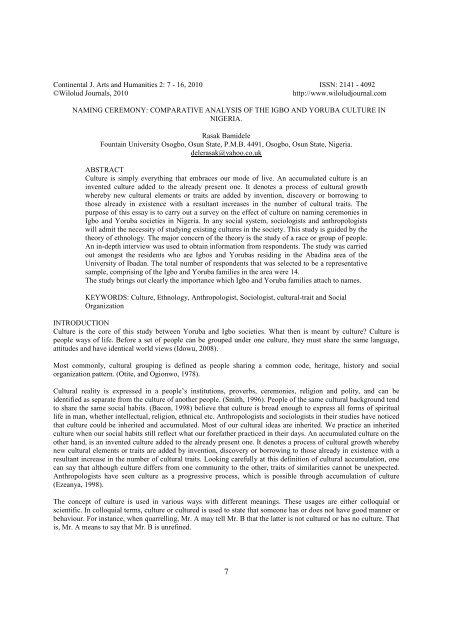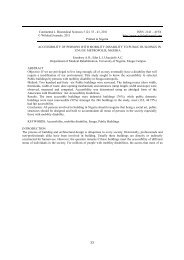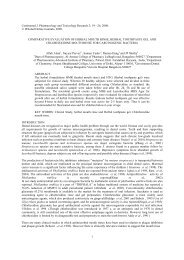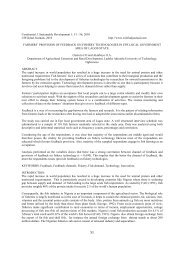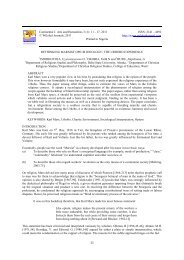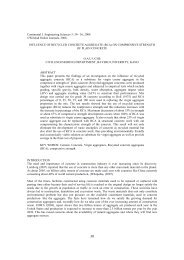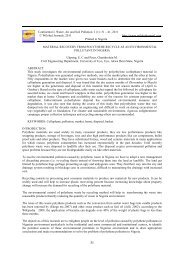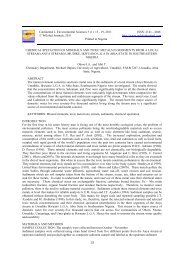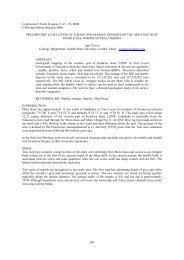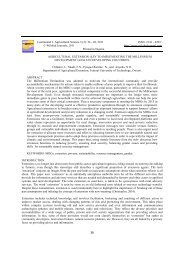Vol 2 - Arts and Humanities - Wilolud Journals
Vol 2 - Arts and Humanities - Wilolud Journals
Vol 2 - Arts and Humanities - Wilolud Journals
You also want an ePaper? Increase the reach of your titles
YUMPU automatically turns print PDFs into web optimized ePapers that Google loves.
Continental J. <strong>Arts</strong> <strong>and</strong> <strong>Humanities</strong> 2: 7 - 16, 2010 ISSN: 2141 - 4092©<strong>Wilolud</strong> <strong>Journals</strong>, 2010http://www.wiloludjournal.comNAMING CEREMONY: COMPARATIVE ANALYSIS OF THE IGBO AND YORUBA CULTURE INNIGERIA.Rasak BamideleFountain University Osogbo, Osun State, P.M.B. 4491, Osogbo, Osun State, Nigeria.delerasak@yahoo.co.ukABSTRACTCulture is simply everything that embraces our mode of live. An accumulated culture is aninvented culture added to the already present one. It denotes a process of cultural growthwhereby new cultural elements or traits are added by invention, discovery or borrowing tothose already in existence with a resultant increases in the number of cultural traits. Thepurpose of this essay is to carry out a survey on the effect of culture on naming ceremonies inIgbo <strong>and</strong> Yoruba societies in Nigeria. In any social system, sociologists <strong>and</strong> anthropologistswill admit the necessity of studying existing cultures in the society. This study is guided by thetheory of ethnology. The major concern of the theory is the study of a race or group of people.An in-depth interview was used to obtain information from respondents. The study was carriedout amongst the residents who are Igbos <strong>and</strong> Yorubas residing in the Abadina area of theUniversity of Ibadan. The total number of respondents that was selected to be a representativesample, comprising of the Igbo <strong>and</strong> Yoruba families in the area were 14.The study brings out clearly the importance which Igbo <strong>and</strong> Yoruba families attach to names.KEYWORDS: Culture, Ethnology, Anthropologist, Sociologist, cultural-trait <strong>and</strong> SocialOrganizationINTRODUCTIONCulture is the core of this study between Yoruba <strong>and</strong> Igbo societies. What then is meant by culture? Culture ispeople ways of life. Before a set of people can be grouped under one culture, they must share the same language,attitudes <strong>and</strong> have identical world views (Idowu, 2008).Most commonly, cultural grouping is defined as people sharing a common code, heritage, history <strong>and</strong> socialorganization pattern. (Otite, <strong>and</strong> Ogionwo, 1978).Cultural reality is expressed in a people’s institutions, proverbs, ceremonies, religion <strong>and</strong> polity, <strong>and</strong> can beidentified as separate from the culture of another people. (Smith, 1996). People of the same cultural background tendto share the same social habits. (Bacon, 1998) believe that culture is broad enough to express all forms of spirituallife in man, whether intellectual, religion, ethnical etc. Anthropologists <strong>and</strong> sociologists in their studies have noticedthat culture could be inherited <strong>and</strong> accumulated. Most of our cultural ideas are inherited. We practice an inheritedculture when our social habits still reflect what our forefather practiced in their days. An accumulated culture on theother h<strong>and</strong>, is an invented culture added to the already present one. It denotes a process of cultural growth wherebynew cultural elements or traits are added by invention, discovery or borrowing to those already in existence with aresultant increase in the number of cultural traits. Looking carefully at this definition of cultural accumulation, onecan say that although culture differs from one community to the other, traits of similarities cannot be unexpected.Anthropologists have seen culture as a progressive process, which is possible through accumulation of culture(Ezeanya, 1998).The concept of culture is used in various ways with different meanings. These usages are either colloquial orscientific. In colloquial terms, culture or cultured is used to state that someone has or does not have good manner orbehaviour. For instance, when quarrelling, Mr. A may tell Mr. B that the latter is not cultured or has no culture. Thatis, Mr. A means to say that Mr. B is unrefined.7
Rasak Bamidele: Continental J. <strong>Arts</strong> <strong>and</strong> <strong>Humanities</strong> 2: 7 - 16, 2010This usage may carry some scientific meaning behind it if Mr. A <strong>and</strong> B come from the same cultural system, that is,anyone misbehaving as objectively determined, has not acquired the behaviour expected of him as a member of aparticular society.In scientific usage, culture is often defined in blanket terms as the total way of life of a people. Specifically, cultureis defined as the complex whole of man’s acquisitions of knowledge, morals, belief, art, custom, technology, etcwhich are shared <strong>and</strong> transmitted from generation to generation. Many anthropologists <strong>and</strong> sociologists accept thisdefinition of culture, which, was given by Taylor (1981, Fadipe, 1990) in his primitive culture. The definitionstresses that culture is not a personal item; culture is used with reference to a society or a group of societies. Culturedoes not die with the death of an individual or a group of individuals. The culture of a people may vanish only whensuch people vanish under such mishaps as earthquakes.Our definition of culture indicates that it has both material <strong>and</strong> non-material aspects, <strong>and</strong> is acquired by everymember of a society. Material culture relates to overt or explicit aspect of culture, <strong>and</strong> means the products ofindustry, technology, art, etc that is, every visible or concrete acquisition of man in society: artifacts such as bridges,pots, cutlasses, hoes, houses, cooking utensil, h<strong>and</strong>icrafts, etc. These are directly observable as the cultural productsof any society. The material aspects of culture thus consist of the objects, which people have learned to make <strong>and</strong>use to satisfy their needs in society.The non-material aspects of culture consist of the knowledge, philosophy, morals, motivation, language, attitudes<strong>and</strong> values etc. shared <strong>and</strong> transmitted in a society. These are sometimes referred to as the covert or implicit aspectsof culture <strong>and</strong> are acquired by members of a society. They are not visible or tangible but they are manifested throughthe psychological states <strong>and</strong> behaviour of a people (Johnson, 2004).Both of these aspects of culture, material <strong>and</strong> non-material go together as the culture of a people. They arefundamental in the analysis of the cultural pattern, that is, the general mode of conduct, the systematic <strong>and</strong> integratedcontent of behaviour, which is characteristic of a society (Oduyoye, 1997). Because of this, it is possible to predictor anticipate the behaviour of members of a society. They are not visible or tangible but they are manifested throughthe psychological states <strong>and</strong> behaviour of a people. It follows therefore that in sociological studies we do notconsider any society or individual as “uncultured”. Every person who is a member of a society or every society inthe world has a culture (Fadipe, 1990).Culture DifferencesCulture differences are the differences between the social habits of people who belong to different linguistic groups.“Communication technique that makes a person successful in New York could kill him in New Delhi” so, also anaming ceremony activities which is acceptable to the Yorubas, might not be acceptable to the Igbos; when we donot share the same culture, we tend to give different interpretations to events; this depends a lot on our culturalbackground which includes unconscious accumulation of the ideas <strong>and</strong> behaviour of one’s culture. Recognizingcultural or ethnic dissimilarities is like recognizing individual differences. (Smith, 1996), explains culturaldifferences with the attitude of the white <strong>and</strong> black people as to time. He illustrate with a colleague of his at auniversity who threw a big dance party for 20 couples made up of blacks <strong>and</strong> whites. The party was scheduled for9.00pm, by 9.30pm most of the white people had arrived but only one black couple had appeared. All the blackspeople did not see anything wrong in coming late. They were simply operating on ‘African people’s time’. Thisillustration may not necessarily be the case, when view from the culture of a black culture toward time. (White,1998), (Sitaram, 1997) <strong>and</strong> (Smith, 1996).The concept of family is another thing that portrays cultural differences between the blacks <strong>and</strong> whites. When awhite man refers to his family, he means just himself, his wife <strong>and</strong> children, while, to an African, with his extendedconcept of family, his family means the husb<strong>and</strong>, wife, children, gr<strong>and</strong>children, cousin <strong>and</strong> in fact all his relations.(Ogbalu, 1997) confirms this statement when he says the Igbos believe that they owe a great deal of responsibility toall whom they are related, that is, their family. Language is another element that can reflect cultural differences. Thecultural differences between two people of Yoruba <strong>and</strong> Igbo cultural background respectively, will make it difficultfor them to underst<strong>and</strong> each other language.8
Rasak Bamidele: Continental J. <strong>Arts</strong> <strong>and</strong> <strong>Humanities</strong> 2: 7 - 16, 2010Custom manifest itself in Igbo <strong>and</strong> Yoruba naming ceremonies. Names in these two linguistic communities; havehigh culture content. A name could reflect gratitude, loyalty or belief in the people’s object of worship, for example“Ogunseun” is a name that shows gratitude to “Ogun” (Yoruba’s god of iron), meaning “thanks be to Ogun”. AnIgbo family can also, name their child “Chika” which means, “God is the greatest”.Naming CeremonyAccording to Ubahakwe (2007), Nigerian indigenous names, like most other African names, have high culturecontent. By this is meant that personal names are not simply labels used for mere identification purposes, as baggagetags are. On the contrary, an indigenous African name on the whole personifies the individual, tells some story aboutthe parents <strong>and</strong> or the family of the bearer, <strong>and</strong> in a more general sense, points to the values of the society into whichthe individual is born. Yoruba people are bounded together like the Igbo people by culture; they are made up ofseveral clans which are bound together by language, traditions, beliefs <strong>and</strong> practices. Naming Ceremony is a widelyobserved culture in Yoruba l<strong>and</strong>. The arrival of a newborn baby is a thing of joy. People in this linguistic group livein compounds; the family blessed with a new child expects congratulatory visits from neighbours <strong>and</strong> relations.When this obligation is not discharged ill feelings result. They sincerely observed significant events fromconceptions to the births of a child. These observations serve as the basis for choosing names for children.Customs dem<strong>and</strong>s that the women who have just gotten a child should be exempted from many things such aspaying visits, going to the streams, cooking etc. In some compound custom permits the woman to go out of thehouse if she so desires after the naming ceremony- in some compounds in Erumu village, in Oyo Yoruba Society, isthe 8 th day, while in some other places like Lalugbon village, in the same Oyo Society, she can only do so after the40 th day when she must have been healthy enough. In Erumu community, male children are given names on the 9 thday, female on the 7 th day <strong>and</strong> twin children on the 8 th day. There are these variations in dates because it’s believedthat a male child has 9 rib bones <strong>and</strong> a female 7.Indigenous Yoruba children usually have two types of names- one he receive as a result of the observation of eventsbefore <strong>and</strong> immediately after birth <strong>and</strong> the other is the one referred to as “Oriki”. This is the name given to a child todescribe the future portents of the child’s life or as a recital of the accomplishments of a clan. It is invoked whenpraising a child for bringing pride to the parents, clan or when attempting to evoke virtuous character traits ofbravery, fortitude, perseverance believed to be innate in a person due to his pedigree. The name of the child is notsupposed to be known by anybody until the day of the person who has the right of choosing names for the child, butif the child’s gr<strong>and</strong>father is still alive, he chooses the name. Naming ceremony is referred to in Yoruba language as“Isomoloruko” meaning giving a name to a child. Others call it “Ikomojade” bringing out of the child. With childrenwho are believed to have brought their names from heaven- these are children born in some unusual manner <strong>and</strong> indifficult circumstances, which make it necessary to prescribe special taboos for the care of the baby. This child canbe named as soon as the baby is born by anybody that can discern children born in such unusual circumstances. Forexample, a child born with his legs coming out before his head will immediately be known <strong>and</strong> called “Ige”.Naming ceremony is one of the most important customs observed in Igbo l<strong>and</strong>. “Igu aha” is the Igbo meaning fornaming ceremony. A woman stays in confinement for 7 market weeks after delivering a child. She <strong>and</strong> her child arenot permitted by custom to come out of the house until the day of the “Igu aha”. She stays all day beside the fireplace (in her bedroom) to keep herself warm <strong>and</strong> to prevent any form of sickness after birth. She does not associatewith anybody; she neither cooks nor serves food to her husb<strong>and</strong> because she is believed to be unclean. Instead, hermother or sisters come around to help with the housework. She is brought special foods such as “Ariraa”, <strong>and</strong>“Awai”, these she takes every day until the 28 th day, the 28 days of confinement is called “Omuguwo” in Igbolanguage.The children are not given names until the 28 th day, there are of course variations in this date. For example, inN’turu in Okigwe in Imo State, the naming ceremony comes up on the 8 th day. Preparations are made towards the“Igu aha” before the actual day, by all Elders in the family. On the day of the ‘Igu aha” the mother <strong>and</strong> child aredressed ready for the ceremony. The Igbo people just like the Yorubas observed significant circumstancesurrounding the birth of a child before a name is chosen for him/her. People of Udi <strong>and</strong> Akwa division in AnambraState believe in reincarnation (Ubesie, 1998). When a child is born they normally consult an oracle to know which9
Rasak Bamidele: Continental J. <strong>Arts</strong> <strong>and</strong> <strong>Humanities</strong> 2: 7 - 16, 2010of their dead gr<strong>and</strong>parents returned back as the new born child. It’s the name of this gr<strong>and</strong>parent that will be given tothe child. Other sources of Igbo names are of event like, giving praise to God, market days <strong>and</strong> nature- this is when achild is given a name relating to springs or rivers. This is common among the Igbo because they believe springs arethe source of life.Interpersonal communication exists in the culture of naming ceremony, since it involves interaction between people.A woman who has just given birth to a child realizes that she immediately starts sharing meaning with her baby. Forexample, the cry of the baby will communicate to her that the child is uncomfortable <strong>and</strong> needs her attention. (Ojike,2005), says that in Igbo l<strong>and</strong> women who are well wishers <strong>and</strong> relations of the family blessed with a new childcommunicate the good news of the arrival of a new child to others by rubbing can wood on their bodies, <strong>and</strong> whenanybody come in contact with them, such a person will know that a child has just been newly born. He/she can thenask who <strong>and</strong> where the child is born so that he/she can go <strong>and</strong> pay a congratulatory visit.Materials used for Naming CeremonyAmong the Igbo people, the naming ceremony day, is a day in which all the relations <strong>and</strong> friends that are present atthe ceremony feast together (Ilogu, 2002). One of the most important things at the ceremony is palm wine. Thefather of the child must make sure there are enough kegs of palm wine for his guests. The significance of palm wineis that, it is used to appease <strong>and</strong> invite the ancestors into their midst. Kola nut is also used for prayer; it is thenbroken in pieces so that all that are present will eat from it. Women from the family where the ceremony is beingperformed cook different types of food from which the family shrine is first fed <strong>and</strong> then the guests. If the family isone that pays prominence to God, they take part of the food to the pastor’s house or the priest.As in the Igbo culture, among the Yoruba people, the naming of a child always attracts ceremonies. The ways theseceremonies are performed differ from one compound to the other. The naming ceremony is generally referred to as“Ikomojade” as earlier mentioned. It is the day in which the child is for the first time, brought out of the room.Hence, the term applies to the event that is, bringing out of the child. Materials used for naming ceremony amongthe Yoruba people differ from one family to the other. However, there are some common items according toDaramola <strong>and</strong> Jeje, (1995); these are bitter kola, salt, honey, cold water <strong>and</strong> hot drink. Adeoye (1992) added fish <strong>and</strong>“Ataare” (Alligator pepper).Each of these materials has its own significance in the ceremony <strong>and</strong> in the life of the child to be named. The headof the family in performing the rites involved in the ceremony takes bitter kola <strong>and</strong> says to the child;( mentioningthe name he has been given) as this bitter kola is strong, so must you be strong in life.He again takes salt, puts it in the child’s mouth <strong>and</strong> says: this salt, as this salt is sweet, so must your life be sweet,<strong>and</strong> because life is as sweet as salt, you should stay <strong>and</strong> eat the salt with us. Honey <strong>and</strong> salt signify almost the samething. Water indicates that the child’s life shall be as cool as water. With the hot drink in h<strong>and</strong>, he says; gin does notfade, may you stay long with us <strong>and</strong> not fade away.The fish signifies food that the parents of the child eat <strong>and</strong> that important people eat meat or fish, the child shouldtherefore grow up to be an important person who will eat meat or fish. One of the seeds of “Ataare” (Alligatorpepper) is removed <strong>and</strong> put on the child’s lips; it signifies that the child should grow up <strong>and</strong> multiply just like Ataare(Alligator pepper) has many seeds.Theoretical FrameworkIn this study the theory of ethnography was taken in consideration- the science of ethnography is the scientific studyof a race or group of people. People without culture are dead. Culture is the totality of the people’s ways of life,beliefs <strong>and</strong> values. It is a regular <strong>and</strong> routine demonstration of the human power, body <strong>and</strong> spirit; personal <strong>and</strong> grouprelationship <strong>and</strong> community responsibilities. It encompasses the arts, music, <strong>and</strong> folklore intellectual development,social institutions, for which the community or society is identified. Culture is not static. It evolves with thedevelopment <strong>and</strong> advancement of the environment in which the society strives. For instance, with the advent ofreligion, the belief of culture of the people is bound to change in response to the new belief system.10
Rasak Bamidele: Continental J. <strong>Arts</strong> <strong>and</strong> <strong>Humanities</strong> 2: 7 - 16, 2010The cultural values of the people nurtured along the pagan religious belief, could also be woven around the newfound religion <strong>and</strong> made to develop along with it. In doing so, the culture of the people under goes some changes,which would also make it grow.In the era of technological advancement, the culture <strong>and</strong> traditions of the people are bound to respond to the changesbrought about by these developments. In applying ethnography, it can be argued that in any social system,Sociologists <strong>and</strong> anthropologists will admit the necessity of studying existing cultures in the society (Bacon,1998).And since naming ceremony is an aspect of Igbo <strong>and</strong> Yoruba cultures the theory of ethnography is of utmostimportance in analyzing traditional activities involved in the naming ceremonies <strong>and</strong> the culture content of Igbo <strong>and</strong>Yoruba names.Objectives of StudyThe primary question addressed by this study is: Is there any effect of culture on the naming ceremonies of both theIgbo <strong>and</strong> Yoruba people in Nigeria?In order to answer this research question, the specific objectives of the study are to explore the cultural areas in thenaming ceremonies of both the Igbo <strong>and</strong> Yoruba people; to examine the culture content of Igbo <strong>and</strong> Yoruba names.In addition, the study examines clearly the importance which Igbo <strong>and</strong> Yoruba families attached to names.METHODOLOGYThe study involved data collection in two stages. The first was the review of secondary sources for backgroundinformation on naming ceremonies in both the Igbo <strong>and</strong> Yoruba people in Nigeria. In the second stage, primary datawere collected using the in-depth interview.The study was carried out in the Abadina residential area of the University of Ibadan in 2009. The choice of this areawas influenced by the fact that households in this area are mixture of both the Igbo <strong>and</strong> Yoruba speaking people.The total number of respondents that was selected for this study was 14. The qualitative data obtained from the indepthinterview were content-analyzed along the main themes of the study.RESULTS AND DISCUSSIONDemographic Characteristics of RespondentsA total of fourteen respondents were interviewed amongst residents who are Igbos <strong>and</strong> Yorubas residing in theAbadina area of the University of Ibadan. This consists of 6(42.9%) Male <strong>and</strong> 8(57.1%) Female. The difference inthe Female-Male representation is a reflection of the fact that more women are interested in social/cultural beliefs.Thus, women participation in cultural activities remains quite high.The age distribution of respondents shows that 6(42.9%) gave no response as regard their age. 1(7.1%) of therespondents fall within 19-24years, while, 3(21.4%) of the respondents reported their ages to fall between 25-30years. And 4(28.6%) respondents reported their ages between 31 <strong>and</strong> above. From this distribution, it appears thatmore of the respondents are not interested in disclosing their age <strong>and</strong> most of the people within this vicinity who aremarried with child/children are above thirty years of age.Respondents’ educational statuses show that 9(64.3%) of the total population holds one form of tertiaryschool/academic qualification certificates, OND, HND, <strong>and</strong> BSc. However, in-depth investigation revealed thatmajority of the respondent who reported to have tertiary-school qualifications had studied courses in Universitieswith certificate or diploma statuses. About 5(35.7%) of the entire population completed Secondary school.1(7.1%) of the population was single, while, 7(50%) were said to be married. 6(42.9%) were said to have beendivorce or separated due to death of their spouse.Analysis of respondents’ religious orientations shows that Christians constitute the single largest group ofrespondents. This accounted for 8(57.1%) of the number of respondents in the study. Muslim makes up 6(42.0%).This shows that within the vicinity under study, the majority of respondents are Christians compare to otherreligions.11
Rasak Bamidele: Continental J. <strong>Arts</strong> <strong>and</strong> <strong>Humanities</strong> 2: 7 - 16, 2010The study shows that 7(50%) of the respondents are from Igbo ethnic group, while, 7(50%) were also from theYoruba ethnic group. This shows that there were equal opportunities given to both target population.In the occupation distribution 3(21.4%) of the respondents did not disclosed their occupation, while, 10(71.4%) ofthe respondents were civil servants, the reason is not farfetched, since the study is carried out with in a governmentinstitution. 1(7.2%) of the respondents were clergy. This shows that target population which the study was proposedfor fall within this bracket.Meaning, Time <strong>and</strong> Date Attached To NamesIn both the Yoruba <strong>and</strong> Igbo societies, meaning are attached to names given to a child. In the family of the firstrespondent, all the children except the last one have “Ade” as the prefix to their names. This means that the parentsof the child have the royal blood in them, because in Yoruba l<strong>and</strong> it is the children born into the families <strong>and</strong> into theextended families of chiefs that have “Ade” (meaning crown) as prefix to their names.The basis for choosing names for children in this family is not only based on events that happened within the nuclearfamily, but on what also happened among the extended family. According to the first respondent, the circumstancesthat determine the choice of names for “Olawale” <strong>and</strong> “Adegoke” were based on what happened to their father’sbrother <strong>and</strong> their paternal gr<strong>and</strong>mother, respectively. This goes to support the position of Fadipe, (1990) which statethat the Yoruba believes that a child born into a family is not only for the husb<strong>and</strong> <strong>and</strong> wife, who had the children,but for all other members of the extended family.The significance of the names given to “Olawale” (meaning wealth comes to the house) <strong>and</strong> “Adeitan” (meaningcrown doesn’t end) according to the first respondent is the direct names of the great gr<strong>and</strong>father <strong>and</strong> the child’sgr<strong>and</strong>father shows the family’s belief in reincarnation. In both cases, the two children are seen as the personality oftheir deceased relations incarnate. The name of the only girl among the children, signifies that before her birth, therewas no female child, so, when the girl was born, the parents were satisfied that their “crown is now complete”. Thenames of all the children in this family show a clear pattern of the family’s fortunes, belief in reincarnation <strong>and</strong> thecircumstances at which the children are born.In the case of the second respondent, all his children except “Oladele” (meaning wealth has gotten home) have“Olu” either, as the prefix or suffix to their names. “Olu” is the short form of the Yoruba word for God, which is“Olorun”. With the occurrence of “Olu” in virtually all the names, the special prominence given to religion inchoosing names for the children is noticed. These names are either acknowledging the power of God, or showing hismercies <strong>and</strong> giving him thanks. From this names, a common fact can be made about the belief of the family, <strong>and</strong>also, on their relationship with the society to which they belong. “Olusegun” <strong>and</strong> “Ebunoluwa” are names whichshow the type of hostility suffered by the family (the parents of the children). “Olumuyiwa” which means “GodHimself brought this” was born after “Olusegun”. At the time this child was born, the family had gotten over thehostility of the past, so, they now say the child is brought to them by God. The names given to all the children aretrue reflections of the life experience <strong>and</strong> the belief of the parents, while it has less to do with the childrenthemselves.The third <strong>and</strong> fourth respondents who happen to come from Afikpo, <strong>and</strong> Ife respectively, claimed that the right tochoose names for their children is basically that of the eldest man in the family. It is noticed that where the eldestman is not available, (as in the case of respondent number two) the father of the child gives the names.According to the fifth, sixth <strong>and</strong> seventh respondents, which were from Ekiti, Ondo <strong>and</strong> Umuahia respectively, “themothers of the children do not choose names for their children”. It then means that the choice of names for childrenis the responsibility of a man.The family of the fifth respondent, who was a Yoruba mother from Ekiti, gives names to her children on the eighthday, while the family of the sixth respondent, a Yoruba father from Ondo gives names to male children on theseventh day.12
Rasak Bamidele: Continental J. <strong>Arts</strong> <strong>and</strong> <strong>Humanities</strong> 2: 7 - 16, 2010According to respondent seven <strong>and</strong> eight, who were Igbo father <strong>and</strong> mother, their reasons for giving names on thethird month for both male <strong>and</strong> female is because tradition <strong>and</strong> culture permit them.For respondent nine, who is from Igbo extraction, claim that one month is the ideal date to name a child to recoverproperly to face the ceremonial problems.Also, respondent ten, also an Igbo father from Umuahia was of the opinion that three month is the ideal date to namea child; reason is to allow the child to be strong. One can rightly depict that the differences in the time interval tendto occur in both culture. It was also discovered that the reason for the differences could be attributed to the culturaldifferences attached to the date <strong>and</strong> time for the naming a new born child. In the Igbo culture the people attachedimportance to market days in carrying out naming ceremony.Materials <strong>and</strong> Processes in Naming a New Born ChildSome difference are reflected in the process of naming children <strong>and</strong> in the materials used by the families of the first<strong>and</strong> second respondents even though they are of the same Yoruba cultural background. Respondent number twomakes provision for religion in the materials used for the ceremony. According to him, who is a traditional Ogunworshipper says that “Ogun” the family’s object of worship is represented by any form of iron material, to show thepresence of that god in their midst. This is a display of his religious affiliation, not in any way provided for by thefirst respondent.The significance of the materials used for the naming ceremony according to the first, sixth <strong>and</strong> thirteen respondents,who were Yorubas, is based on the belief of the Yorubas about life. The materials are either signifying that the childshould live a happy life, or that he should have many offspring. The responses of these three respondents show thatthe custom involved in giving names to children have slight difference even among people of the same culturalbackground. This confirms that among the Yoruba people, there are variations in the practice of naming ceremoniesfrom one family to another (Ogunbowale, 1990). The basis of these variations could be due to the differentprocesses at which each of the people got in contact with external culture <strong>and</strong> education, however, there are st<strong>and</strong>ard<strong>and</strong> practice common to the entire group.Respondents, three <strong>and</strong> four were both of Igbo cultural background; the names of the children of the thirdrespondent are reflections of what the family is deeply concerned with. This according to him shows the words ofthe names of the children, except the last one, refer to “Chukwu” (the great God) or “Chi”, the personal deity(another name for God). This could mean the extent to which this family practices religion.It is noticed that these names are either recognizing the power of God, or praising <strong>and</strong> thanking him for his deeds.According to him, the name “Okundiri” of the last child, however, tells something about the social relationshipbetween the family <strong>and</strong> the people in their community. The meaning according to him of this name shows a tensedatmosphere that even the birth of the child has not relieved.In the case of the fourth respondent, only two of the four names that he gave have something to do with the religiousbelief of the family. ”Mmadukaego” is a name that reflects the Igbo <strong>and</strong> especially the family’s concept of life, thefear of death <strong>and</strong> the importance of having relationship over being rich, could have influenced the choice of thisname which says “man is greater than money”. The female child was named “Nwayioma”, meaning “a goodwoman”. This is a name that says what the child is to the parents. There is a connection between these types ofnames with a marked ceremony, which is supposed to be a common practice all over Igbo l<strong>and</strong>. Among the Igbofamilies interviewed only one did not performs the naming ceremony, while some just give names to their childrenwithout marking it with any ceremony because they have not got the money. The reason gives by the fourthrespondent is based on urban area influence. Probably, if he was to be in the village, this complaint would not havecome up; because neighbours <strong>and</strong> relations may have to provide virtually all the materials he would need for theceremony, due to the extended family system practice in the village. But because people in city are mostly notconcerned with this type of communal help pattern, it may be difficult for him to come by such help.13
Rasak Bamidele: Continental J. <strong>Arts</strong> <strong>and</strong> <strong>Humanities</strong> 2: 7 - 16, 2010The third respondent on her own says that the naming ceremony is performed any time when there is money. Thiscontrasts shows difference with what respondents’ one <strong>and</strong> two have said about the dates the naming ceremony isperformed. The choice of gin over palm wine or any other traditional gin (Ogogoro) must again be the effect ofvalues <strong>and</strong> cultural differences of the family of the third respondent.According to respondent four on the process of naming ceremony: On the morning of the naming ceremony, thepaternal gr<strong>and</strong>mother of the child takes him or her out of the room into the midst of people who are cited for thenaming ceremony, the name to be given to the child is already written on a sheet of paper in a dish that is placed onthe table, where the other materials for the ceremony are. The ‘Elder’, who is leading the ceremony, takes the child,as he says the name he has been given. He simultaneously touches the lips of the child with each of the materialsprovided as he prays for the child.According to the fifth respondent: the Elder sit in the middle of the people who have come for the ceremony. Theelderly man presiding over the ceremony uses chalk to draw a circle on the floor <strong>and</strong> he introduces the child into theworld by putting the child’s legs inside the circle that has been drawn. He then tells the people the name that hasbeen chosen for the child <strong>and</strong> prays for the child with each of the materials provided.According to the sixth respondent: On the morning of the naming ceremony, ‘my child <strong>and</strong> I wear new things’. Theelder who is naming the child prays for him/her with the hot drinks <strong>and</strong> kola nuts.He then pours a bit of the drink on the ground before he gives to everybody present to drink. After praying with thekola nuts, he breaks it into pieces <strong>and</strong> all the people present eat from it.There was no response from respondent seven on the process of naming his children.Respondent eight: The mother of the child is asked to sit on a mat <strong>and</strong> a bow is placed on the mat, the mothercarrying the child open up the mouth of the child <strong>and</strong> the soup prepared is drop into the child’s mouth, this signifiedthat the child is introduced into eating of pepper <strong>and</strong> salt.The ninth respondent simply gave the reason for process in naming a child as Yoruba tradition.According to respondent ten: The head of the family submits selected name(s) to the elders in the hamlet who arepresent at the ceremony.For respondent 11: people are invited, that is, family members <strong>and</strong> close friends, even in-laws. Roasted yam will beprepared <strong>and</strong> red oil with which to eat it with. The hot drink will be ready too. The mother of the child will beinstructed to present the child for naming, once that is done, the eldest man in the family will pronounce the name;<strong>and</strong> entertainment will follow immediately, then the closing prayer.There was no response from respondent 12.The process for respondent 13 is simply praying with the materials by the eldest man for long life for the child.According to respondent 14: the parents send a town crier or any member of the family to inform the elders aboutthe preparation or intension to name their child. You then cook for the visitors, the people contribute money for thechild as well as pray, <strong>and</strong> the parents are allowed to open an account with the money so contributed for the new bornbaby.The other respondents had similar responses from the above, in which they attribute the process of naming a child totraditional belief of the people.14
Rasak Bamidele: Continental J. <strong>Arts</strong> <strong>and</strong> <strong>Humanities</strong> 2: 7 - 16, 2010CONCLUSIONThe discussion brings out clearly the importance, which Igbo <strong>and</strong> Yoruba families attached to names. It means muchmore to them than just labels for differentiating one individual from the other. Each name tells a story about theindividual, his family, <strong>and</strong> the society into which he belongs. The significance attached to names is also reflected inthe ceremony that is used to mark the giving of names to children.The Yoruba <strong>and</strong> Igbo people believed that the prayers offered for the child on his naming ceremony play animportant role in the life of the child thus named. This is why the Yorubas need so many materials to signify all thatthe child will meet in life.The belief <strong>and</strong> in the materials prepared for his naming- ceremony, for example, it is a wish (of the Yoruba people)that someone should live a long life. This is signified in the ceremony with the offering of prayers over each of thematerials used. During the prayers, special requests are made for a life worth living <strong>and</strong> an enjoyable one for thechild. The Yorubas also believed in having many children, <strong>and</strong> right from the day of the naming ceremony, theyshow concern for the child being able to have many offspring of his or her own later in life.This prayer for many children is signified with alligator pepper (Ataare). We also get to know about the beliefs ofthe Igbos <strong>and</strong> Yorubas in reincarnation through the names given to children. Reincarnation in a child is taken as ablessing especially if the deceased Elder was an important person in the family. However, in Igbo society the namegiven to a child on his naming ceremony are believed to be able to have influence in his future. Ubahakwe (2007)took a leaf out of Wieschoff’s article to explain this belief among the Igbo. “An ominous name is likely to spellhardship <strong>and</strong> ultimate doom for the bearer. When such names are given to children, in future people will be quick inrelating the misfortunes of such children to their names”. A child named “Ngozi” (meaning Blessing) or “Obiageli”(meaning one who comes to eat) is said to be most likely to have a bright future <strong>and</strong> less of misfortunes.The work then concludes that Igbo <strong>and</strong> Yoruba names <strong>and</strong> the naming ceremony involves are embodiments ofculture, which give insight into the beliefs, customs, values <strong>and</strong> attitude of the people studied. From the result of theresearch carried out, among some respondents who reside in Abadina junior staff quarters, University of Ibadan.This is an academic environment where the strict practice of custom <strong>and</strong> culture may not be strictly observed by theinhabitants. The life in the city must also have influenced the way some of the respondents have deviated from thecultural practice of the naming ceremony.REFERENCESAdeoye, C. (1992). Oruko Yoruba: Ibadan Oxford University Press.Bacon, B. (1998). Enclopaedia of Religion: Morrison <strong>and</strong> Gibb limited; <strong>Vol</strong>. VI.Daramola, O. <strong>and</strong> Jeje, A. (1995). Asa ati Orisa Ile Yoruba: Onibonoje press, Ibadan.Ezeanya, S. (1998).Igbo Christian Names: C.M.S Press, Port Harcourt.Fadipe, N. (1990). The Sociology of the Yoruba: Ibadan University Press, Ibadan.Idowu, E. (2008). Olodumare, God in Yoruba Belief: William Clones <strong>and</strong> Sons Limited, Great- Britain.Ilogu, E. (2002). Christianity <strong>and</strong> Igbo Culture: Bill Leiden, London.Johnson, S. (2004). The History of the Yorubas: Lowe <strong>and</strong> Brydone Printers Limited; London, pp 79-80.Oduyoye, M. (1997). Yoruba Names, Structure <strong>and</strong> Meaning: Daystar Press, Ibadan.Ogbalu, F. (1997). Igbo Institutions <strong>and</strong> Customs: University Publishing Company, Onitsha, Nigeria.Ogunbowale, P. (1990). Asa Ibile Yoruba: Oxford University Press, Ibadan.15
Rasak Bamidele: Continental J. <strong>Arts</strong> <strong>and</strong> <strong>Humanities</strong> 2: 7 - 16, 2010Ojike, M. (2005). My Africa: Richard Clay <strong>and</strong> co. Limited, Great Britain.Otite, O. <strong>and</strong> Ogionwo, W. (1978). An Introduction to sociological studies. Ibadan; Heinemann EducationalLimited.Sitaram, K. (1997). What is Intercultural Communication? :Wadsworth Publishing Company, Inc. California.Smith, L. (1996). Trans Racial Communication: Prentice Hall Inc. Engle Wood Cliff, New Jersey.Ubesie, T. (1998). Odinala Ndi Igbo: Oxford University Press, Ibadan.Ubahakwe, E. (2007). Culture Content of Igbo Personal Names: Nsukka, Nigeria.White, L. (1998). The Science of Culture: Harcourt Brace, New York.Received for Publication: 09/06/2010Accepted for Publication: 21/07/201016


